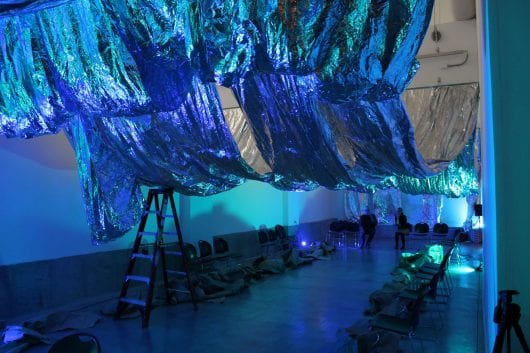
The installment, called “Shale Forming,” was created by Jacklyn Brickman, a second-year in Studio Art MFA. Credit: Nicholas Youngblood | Lantern Reporter
Tucked into a corner in Hopkins Hall is a room filled with dozens of film reels stacked on shelves, loose film hanging on coat hooks, and camera equipment and projectors on every flat surface.
However, this is not a storage closet. It is the office of Roger Beebe, a professor and adviser for the studio art master’s program at Ohio State.
Typically only 10 percent of applicants are accepted into the program. This year the department only sent out 12 offers out of 106 applicants.
Beebe said he is proud of the art MFA program at Ohio State.
“I think it’s actually a bit under the radar,” he said. “As competitive as it is, we are able to get some really great classes of students … It’s really rare to have a program like ours, and with the quality of faculty we have and with the resources we have at our disposal.”
Beebe said the studio art MFA program gives its students all the tools they need to better themselves as artists and to take their careers further.
Opportunities presented to studio MFA students include a private studio, a graduate teaching assistant position, a stipend, study-abroad programs and unrestricted schedules to fill with artistic development.
“The MFA program is like the best grant you will ever get,” Beebe said. “It’s like getting $100,000 of studio time and financial support over three years.”
While most programs last only two years, Ohio State allows its studio art master’s students to explore their direction a little more over the course of three years.
“You can really allow yourself to have the first year to experiment,” Mitch Vicieux, a first-year in the program, said. “In other programs with two years, you’re expected to go straight into your thesis work in your second year after you had just gotten acclimated to the program.”
Vicieux, one of Beebe’s advisees, specializes in video and 2D animation. Vicieux said they typically incorporate animation on top of live action film for documentaries and film essays, which falls under the MFA’s “Art and Technology” discipline that includes many modern forms of expression, ranging from video to interactive design and robotics.
Beebe said Ohio State is ensuring that artists of all disciplines are engaging in multifaceted work.
“Contemporary artists need to diversify,” Beebe said. “Art is made through engagement with subject matter that comes from different places.”
Vicieux said this facet is crucial to learning.
“Interdisciplinary study is so important to the MFA program here,” they said. “It is so essential for us to be looking at work outside our own genres.”
Jacklyn Brickman, a second-year MFA student, is a prime example of interdisciplinary study as she focuses on installation art. Brickman fills rooms with her expansive, interactive work that incorporate robotics, sensors, videos and even live dance performances.
Currently, she is building an installation at the Urban Arts Space downtown as a set for dance MFA student Katherine Moore’s thesis performance.
Previously, Brickman worked with the biology department at the university, building installations inspired by plant physiology.
“I think one of the most exciting things for me about being at Ohio State is how supported and encouraged collaboration is,” Brickman said. “So, part of why I came is for the art and tech program where the [faculty] are constantly working on collaborations with other departments.”
Brickman said the program recognizes there isn’t one specific path to inspiration and enables its students to be innovative and curious in their exploration of art.
“I really feel like Columbus and OSU are really the land of ‘Yes!’,” Brickman said.


